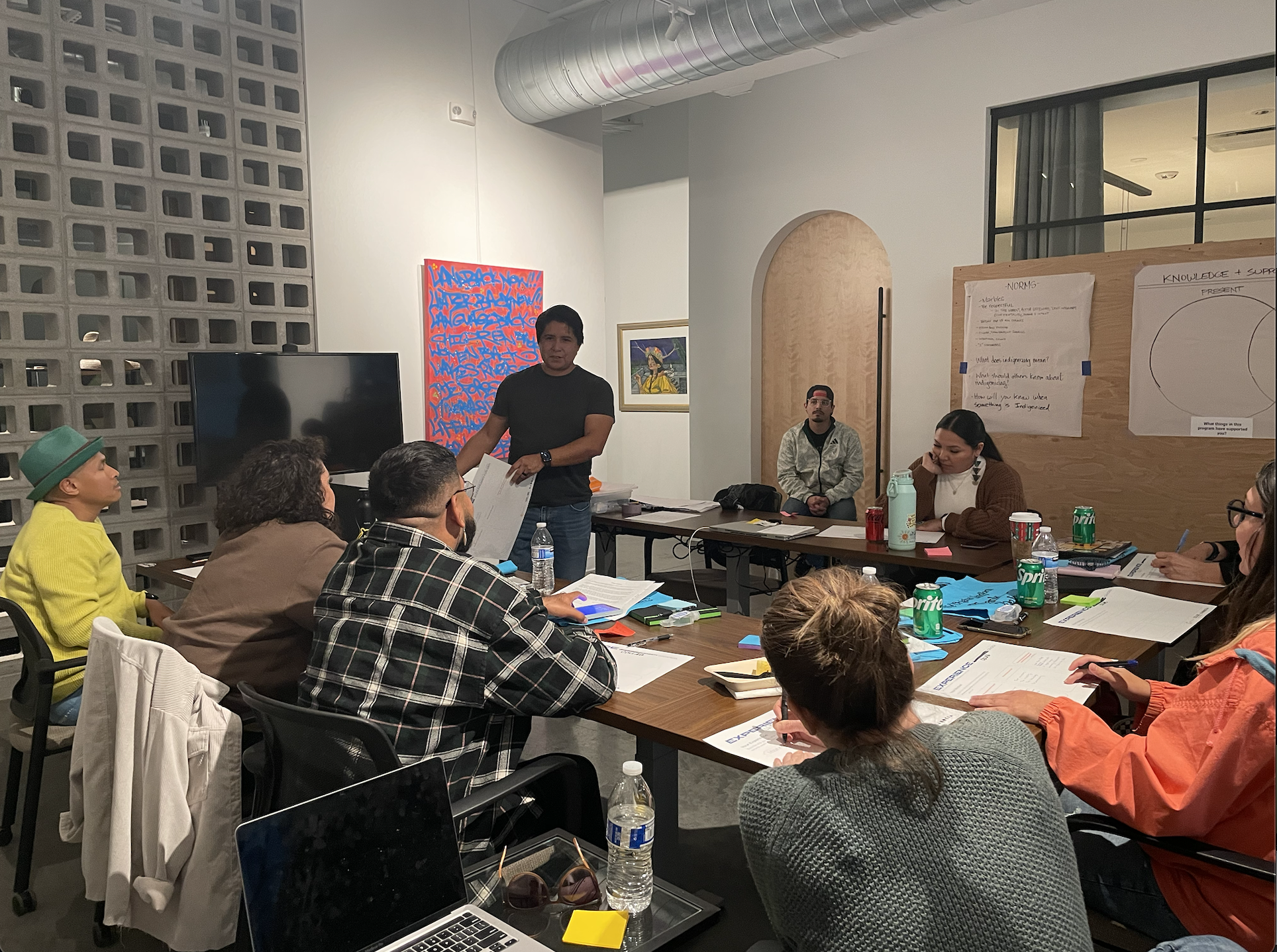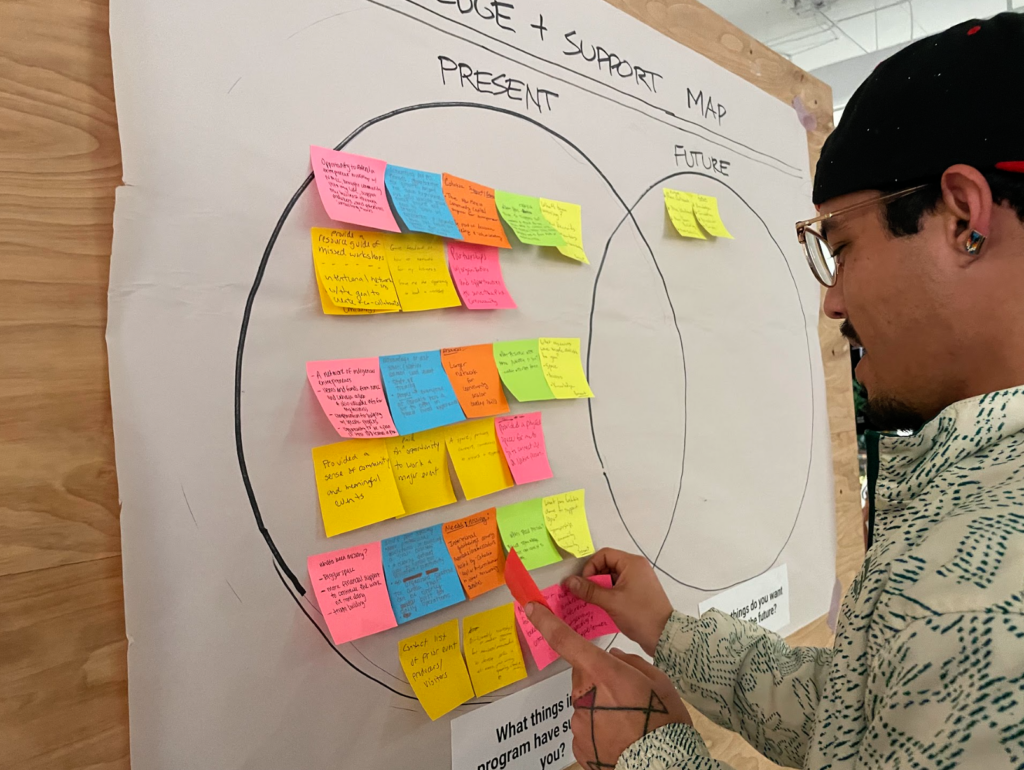Part 3: Building Design and Research Activities with Community Partners

Catapult Design in partnership with a collective of Arizona-based Indigenous organizations, including CahokiaPHX, Brian Skeet Design LLC, and Indigenous Community Collaborative, worked to center Indigenous designers, creatives, and entrepreneurs by co-creating an Indigenizing Design Framework. This project was funded by the National Endowment for the Arts 2022 Design Grant.
This is the third blog post in a series of posts about the creation of the Indigenizing Design Framework.
To understand and define what ‘Indigenizing’ means, Catapult Design and our partners, CahokiaPHX, Brian Skeet Design LLC, and Indigenous Community Collaborative, collaborated with the local intertribal community of Indigenous creatives, designers, and social entrepreneurs from both urban and reservation-based communities that are involved in CahokiaPHX’s programs, as well as Indigenous vendors and visitors from CahokiaPHX’s Holiday Pop-up Market in Phoenix, AZ.
We identified key research goals and questions to guide us as we began engaging with the local community members, which helped us to identify what was most important to learn and the best way to do so. Our Partners brought past and existing Indigenous knowledge to the topic of Indigenizing by introducing us to Indigenous scholar and architect, Wanda Dalla Costa’s Indigenous Placekeeping Framework. Utilizing Costa’s work as a reference point, CahokiaPHX and Catapult Design employed this Framework as their initial step in defining ‘Indigenizing‘ and the language being used to describe it, subsequently identifying the following research goals:
- Language of Indigenizing – Identifying the language used by the community to define what Indigenizing is and the values that describe it.
- Practice of Indigenizing – Understanding how Indigenizing manifests in their work, the current challenges they face when Indigenizing, and what a better future looks like.
- Cultural Identities of the Community – Surfacing the individual tribal heritages, cultural identities, and experiences of the community members to discern how their identities impact their definition and relationship to Indigenizing.
Defining Research Methods & Activities
Through a very collaborative design process with our Indigenous Partners ( learn more about this in our previous blog post here), we were able to identify focus groups as the design research method that would be most helpful for the CahokiaPHX project team–Melody Lewis, Brian Skeet, and Mike Webb–to engage in meaningful dialogue with the two groups of community members. The focus group approach proved valuable in gaining insights into individual and collective priorities within the community. Both focus group sessions were guided through three activities tailored to the local participant context, as well as the research goals and questions. These activities were developed with sensitivity toward participant accessibility, safety, and engagement. The activities included:
1. Creative Identity Map

The Creative Identity Map actively was focused on surfacing community members’ cultural backgrounds, perspectives, and definitions of Indigenizing both as an individual and as a collective. Participants were asked to individually reflect on their personal backgrounds and their unique lived experiences by filling out an Identity Card, which asked them a mixture of open and closed questions. This was followed by a group share-out where they held space for each other’s thoughts on their journey as Indigenous creatives and entrepreneurs.
Then they were guided through a reflective discussion supported by sticky notes, where they defined ‘Indigenizing’. This activity helped to surface:
- An understanding of the cultural background and creative practice of the participants.
- Shared definitions of the priority Markers for Indigenizing.
- A discussion on the Markers of Indigenizing (read about the Markers in our first blog post here) to understand what they mean to the participants and what they look like in practice.
2. First Experience Journey Map

This journey map exercise aimed to comprehend each individual’s motivations and experiences within the CahokiaPHX space, providing context to their perceptions of the Indigenizing process at CahokiaPHX. They were asked to describe how the space supported their creative journey, their motivations for joining, and what they were hoping to get from their experience there. This activity helped to surface…
- Stories of the participants’ early experiences with CahokiaPHX demonstrate how the space supports their journey as creatives and entrepreneurs.
- Ways that CahokiaPHX can continue to play a supportive and enabling role in the Indigenous creative and entrepreneurial ecosystem in Phoenix, Arizona.
- The participants’ mindsets and motivations to work with CahokiaPHX and how the space can support newcomers.
3. Present and Future Knowledge Map

The final activity focused on understanding practices of Indigenizing; what’s currently working and what can be improved. Community members were guided through rapid brainstorming and facilitated dialogue during this activity. The aim was to uncover how Indigenizing is currently integrated into CahokiaPHX’s ecosystem, how this integration can be improved, and how it shows up in practice. The conversation flowed between the past, present, and future as Indigenous knowledge perceives them, enabling participants to take a cyclical, process-based approach to their share-outs.
The Activity Helped to Surface…
- The people, resources, knowledge, methods, and mindsets that play a role in the process of Indigenizing within the CahokiaPHX ecosystem.
- An understanding of how Indigenizing is currently happening, and envisioning a future of what is needed to strengthen and amplify Indigenizing.
Our design process and activities resulted in the development of an Indigenizing Design Framework that includes three main outcomes that support the teaching and learning of the process of Indigenizing (read more about the framework here). The Indigenizing Markers are contextual, cultural, and place-based. By supporting the community to frame and share their narrative, we built a common language that ensures their lasting ownership over the design process and its outcomes.
If you enjoyed this article on the ins and outs of building an Indigenizing Design Framework, check out our other posts in this four-part series:
To learn more about the Indigenizing Design Framework and project, download and read the report. To find out more about how National Endowment for the Arts grants impact individuals and communities, visit www.arts.gov.
Topics/Site Tags
- Partnership, Latest News, Indigenizing, Entrepreneurship, Co-design, Human-Centered Design, Indigenous, Design Research
- Dalla Costa, W. (2018 in press). “Teaching Indigeneity in Architecture: Indigenous Placekeeping Framework.” In Kiddle, R., Stewart. L.P & O’Brien, K. (eds). Our Voices: Indigeneity and Architecture, ORO Editions, New York, NY, USA: 146–153.




